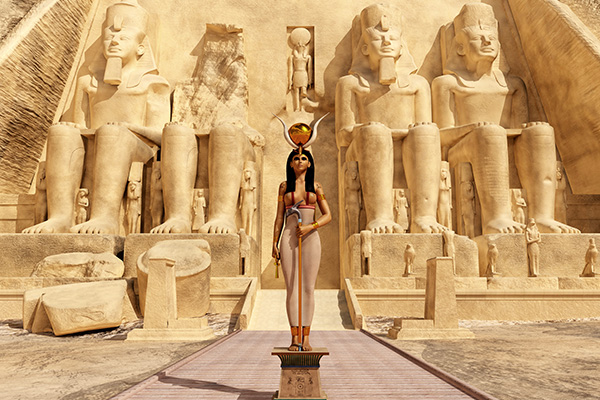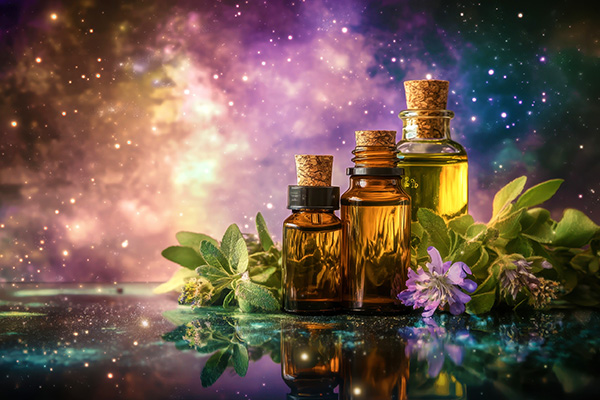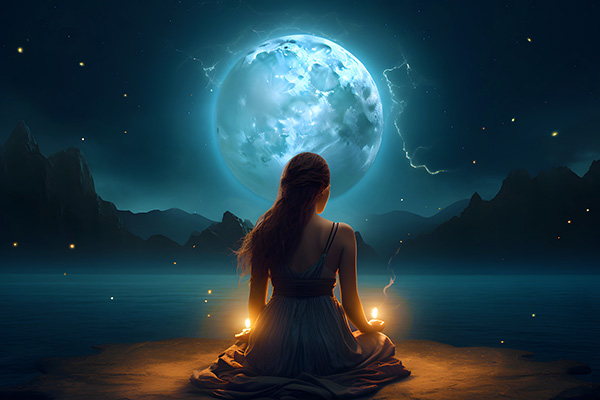Spirituality
What I Learned From Egyptian Goddess Hathor
 From the moment I first encountered her, Hathor, the ancient Egyptian goddess, she felt like a luminous companion on my spiritual path.
From the moment I first encountered her, Hathor, the ancient Egyptian goddess, she felt like a luminous companion on my spiritual path.
To me she isn’t just a myth or a symbol. She’s a living presence and a spiritual guide. She’s also a gentle yet powerful presence in my psychic and healing work. Her energy speaks to me on a deeply intuitive level.
My connection with Hathor began unexpectedly while reading a book on ancient Egypt. Suddenly, I felt a comforting warmth surround me. It was as if a long-lost friend had returned.
Then, I was guided to raise my hands, palms facing outward and I sensed her hands and palms facing mine. A glow of golden light flashed before me and I felt a warm sensation entering my palms and almost as though my hands were being supported and held, and all time was suspended.
In that timeless and powerful moment, Hathor’s nurturing love enveloped me, and her ancient wisdom whispered that time is merely a construct.
In the Infinite Light, there is no past or future, only this sacred now. In is in the present moment that healing and miracles unfold.
As a psychic, I find that Hathor naturally aligns with my practice. She is not just the goddess of love and beauty, though she radiates both. She embodies a vibrant, nurturing energy that opens emotional and spiritual channels.
Things You May Not Know About Our Psychic Readings
 Did you know? The popularity of psychic readings continues to rise as more people seek meaning beyond the material and answers that speak to the heart and soul.
Did you know? The popularity of psychic readings continues to rise as more people seek meaning beyond the material and answers that speak to the heart and soul.
According to a recent Pew Research Center study, 30% of U.S. adults consult psychics and astrologers at least once a year. Fourteen percent do so monthly, and approximately 6% engage with psychics weekly. In our experience, these numbers reflect more than mere curiosity or entertainment value. They point to a cultural shift toward viewing psychic reading as a meaningful resource for navigating life.
Psychic readings are increasingly recognized as a valuable tool for self-discovery, emotional healing, and spiritual growth. In today’s fast-paced and uncertain world, people are turning to psychics and mediums for connection, clarity, and comfort.
This growing interest isn’t just a trend; it represents a broader spiritual awakening. As mindfulness, mental health awareness, and holistic wellness become more prominent, people are revisiting ancient spiritual teachings and practices through a modern lens. Psychic readings provide a sacred space to pause, reflect, and explore life’s deeper questions. Instead of being an escape from reality, they offer a way to engage with it more consciously, with spirit and intuition as trusted allies.
As more people embrace the metaphysical dimensions of their lives, psychic readings are becoming essential companions on the journey toward wholeness and self-understanding. There are several important reasons why this is happening, as well as a few surprising truths about psychic readings that people often don’t realize. Continue reading
Why Psychics, Healers And Empaths Use Essential Oils
 Essential oils have long been sacred allies in spiritual and healing traditions around the world. Extracted from the aromatic essence of plants, these oils carry more than just fragrance; they carry the energetic blueprint and vibrational frequency of their botanical origins.
Essential oils have long been sacred allies in spiritual and healing traditions around the world. Extracted from the aromatic essence of plants, these oils carry more than just fragrance; they carry the energetic blueprint and vibrational frequency of their botanical origins.
In spiritual practice, essential oils are potent tools for emotional alignment, energetic cleansing, and deepening our connection to the self, spirit, and earth, far surpassing their role as mere pleasant scents.
Essential oils act as bridges between the tangible and the intangible. They provide sensory cues that encourage relaxation of the body, focus of the mind, and openness of the spirit. While they don’t replace deep inner work or professional guidance, they provide gentle, supportive energy that enhances existing practices.
The use of essential oils in spiritual practices is anything but modern. Prophets, priests, shamans, and oracles across the ancient world worked with aromatic oils and resins as sacred tools to facilitate divine connection, purification, and inner vision.
In ancient Egypt and the Near East, frankincense and myrrh were revered not just for their fragrance, but for their ability to open spiritual gateways. Frankincense, often referred to as “liquid gold,” was burned in temples and used in rites of passage. Myrrh featured in sacred anointing blends and was considered essential for emotional release and spiritual attunement.
Manifest Your Best Life With The Moon Phases
 Aligning with the moon’s phases is a powerful tool for manifestation, emotional balance, and energetic cleansing. Its ever-changing phases offer varying energy frequencies that can be used to improve many aspects of life.
Aligning with the moon’s phases is a powerful tool for manifestation, emotional balance, and energetic cleansing. Its ever-changing phases offer varying energy frequencies that can be used to improve many aspects of life.
Many ancient traditions revered the moon as a divine feminine force. Honored as a celestial goddess, her light was believed to guide humanity. Her journey across the sky mirrored the universal cycles of life, death, and rebirth that govern everything.
For the Greeks, the moon was Selene, the shining personification of lunar power, radiating purity and grace as she drove her chariot across the night sky. Selene was also linked to Artemis, the fierce goddess of the hunt and wild places. This connection embodied the moon’s untamed nature and its link to the wilderness.
Another important figure was Hecate, the formidable goddess of magic, witchcraft, and crossroads. She represented the moon’s mysterious and powerful aspects, guiding souls through the night. In Indian mythology, Chandra, the moon god, personified beauty and light, bringing calmness and tranquility to the night.
Throughout these ancient traditions, the moon was consistently viewed as a mysterious guide and careful keeper of sacred timing. Her rhythm influences everything from harvests to human emotions.
When we intentionally tune into this ancient, cosmic rhythm, we discover the profound, often subtle ways the continual ebb and flow of lunar energy directly influences our inner being and daily life. Our emotions, energy levels, and thoughts are closely tied to the moon’s gravitational pull and energy shifts.


